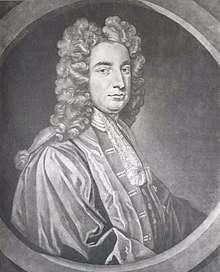Richard Helsham

Richard Helsham (1683–1738) was an Irish physician and natural philosopher at Trinity College, Dublin. He was the inaugural Erasmus Smith's Professor of Natural and Experimental Philosophy from 1724 and Regius Professor of Physic from 1733.[1]
Life
Helsham was born at Leggatsrath, County Kilkenny, was educated at Kilkenny College, and entered Trinity College, Dublin on 18 July 1697. He obtained a scholarship in 1700, graduated B.A. in 1702, was elected a fellow in 1704, and was co-opted a senior fellow in 1714.[2]
A practising physician, Helsham was lecturer in mathematics 1723–30, and was the first to hold the professorship of natural philosophy on the foundation of Erasmus Smith, 1724–38. He was also Regius Professor of Physic in Dublin, from 1733 to 1738.[2]
Helsham was a friend of Jonathan Swift, and of Dublin men of letters generally, including Michael Clancy and Patrick Delany.[2][3][4] He died on 25 August 1738, and was interred in the churchyard of St Mary's Church, Dublin.[2]
Works
Helsham's Lectures on Natural Philosophy, edited by Bryan Robinson, were published in 1739, and a second edition appeared in 1743.[2] He found an inverse-square law in magnetism, but the early editions do not treat electricity.[5][6]
With Patrick Delany, Helsham wrote an anonymous political pamphlet, A long history of a short session of parliament in a certain kingdom (Dublin, 1714). It was aimed at the Irish Parliament, was considered scandalous, and was ordered to be burnt by the common hangman. The Privy Council offered a reward to discover its author.[7]
Family
Helsham married Jane Putland, widow of Thomas Putland, in 1730. Her unmarried name was Rolton.[1]
Notes
- 1 2 Welch, H. T. "Helsham, Richard". Oxford Dictionary of National Biography (online ed.). Oxford University Press. doi:10.1093/ref:odnb/12877. (Subscription or UK public library membership required.)
- 1 2 3 4 5

- ↑ Esposito, Anthony. "Clancy, Michael". Oxford Dictionary of National Biography (online ed.). Oxford University Press. doi:10.1093/ref:odnb/46671. (Subscription or UK public library membership required.)
- ↑ Barnard, Toby. "Delany, Patrick". Oxford Dictionary of National Biography (online ed.). Oxford University Press. doi:10.1093/ref:odnb/7443. (Subscription or UK public library membership required.)
- ↑ Roderick Weir Home (8 March 2015). Aepinus's Essay on the Theory of Electricity and Magnetism. Princeton University Press. p. 171 note 75. ISBN 978-1-4008-6952-7.
- ↑ Michael B. Schiffer; Kacy L. Hollenback; Carrie L. Bell (2003). Draw the Lightning Down: Benjamin Franklin and Electrical Technology in the Age of Enlightenment. University of California Press. pp. 288 note 16. ISBN 978-0-520-23802-2.
- ↑ James Kelly, Regulating print: The state and the control of print in eighteenth-century Ireland, Eighteenth-Century Ireland / Iris an dá chultúr Vol. 23 (2008), pp. 142–174 at p. 161. Published by: Eighteenth-Century Ireland Society. Stable URL: https://www.jstor.org/stable/27806928
Attribution
![]()